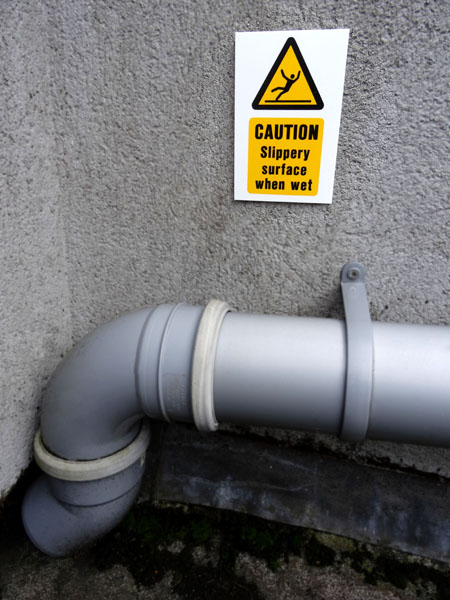
The slippery when wet sign does what it says on the tin: it warns people of wet, dangerous flooring. Whether it’s been cleaned or there’s been a spillage, a “caution slippery when wet” sign is essential to safeguard people from potentially life-changing falls and slips.
The sign has been used so often in modern life that it’s difficult to imagine life without it. How did people survive without the sign, and what are the consequences of refusing or incorrectly using one?
Why Should You Use A “Caution Slippery When Wet” Sign?
Slipping is now the most common form of workplace injury according to the Health and Safety Executive (HSE), making up 31% of non-lethal accidents. In 2017/18, 3.9 million workdays were lost as a result of non-fatal workplace injuries, meaning slips were responsible for roughly 1.3 million of those. In essence, slipping costs businesses both in lawsuits and lost labour days.
Many accidents can be avoided with proper use of wet floor signs. While slips, trips and falls have a multitude of causes, not properly signposting spillages and wet floors still contributes a significant amount to these accidents. Not only does this leave liability on the property owner, but it can also lead to a demoralised and injured workforce.
How Much Could Improper Use Cost You?
Even to this day, businesses are still making near-fatal mistakes when it comes to slippery when wet signs. Not only must businesses identify when a spillage has occurred, but they must also ensure the sign is set-up and maintained properly.
For example, a casino in Cincinnati had to award a woman $3 million in compensation after she slipped on a flat wet floor sign. An employee of the business had walked past the sign without propping it up before the woman slipped and suffered life-changing injuries.
This was a rare case of the importance of using these signs properly. Signs must be placed in clear view, as well as be placed on a stable footing. As the case above shows, a sign itself can become a danger, costing businesses and lives.
How to Use a Wet Floor Sign
If you want to follow wet floor sign best practice, then you need to hit the following guidelines:
- Ensure there is a wet floor sign available for every entrance, including warehouses, just in case it’s a particularly wet day. These are well suited for icy, and snowy conditions.
- Make sure there is a sign for all bathrooms.
- If your business has a kitchen, then you’ll need signs ready for near the dishwasher and roughly 3 to account for spillages.
- Make sure signs are prominently placed so that employees and customers can see them when walking into wet areas.
- Place signs around both sides of a spill. Triangulating around the spill is also a decent option if you have the spare signs. Alternatively, you could use our barrier tapes.
- If the spill is around the corner, then place one sign in sight beforehand.
Overall, there’s never such thing as playing it too safe when it comes to wet floor signs. Always be prepared for the worst-case scenario.
Label Source stocks the best in slippery when wet signs as part of our warning signs range, suitable for a variety of businesses. For more from the ever-changing world of labels, safety and workplace efficiency, be sure to follow Label Source on Facebook and Twitter.